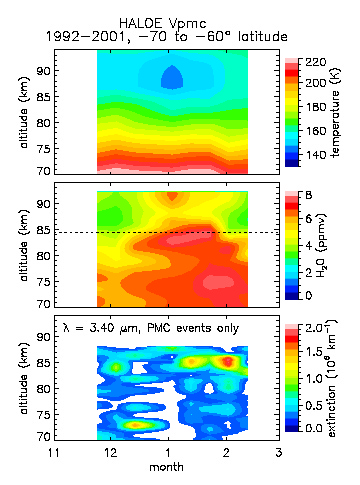HALOE Vpmc: A New Version of HALOE Data Targeted to the Polar Mesosphere
HALOE measurements are used to
retrieve
profiles of aerosol extinction at four wavelengths (2.45, 3.40, 3.46,
and 5.26 microns) and seven gas mixing ratios
(HF, HCl, CH4, NO, NO2, H2O, and O3). Temperatures are retrieved
at altitudes from 35 to 85 km. In the current public data release
(V19), temperature,
O3, and H2O retrievals are corrupted by interfering PMC
extinction. Improvements beyond V19 have been
implemented, including the removal of PMC contamination in
temperature,
O3, and H2O retrievals, and the addition of particle
extinctions retrieved at 6.26 micron wavelength. Our first
reprocessing
was Vpmc1.0, and improvements were implemented in a second reprocessing
(Vpmc1.1). Cumulative changes from V19 to Vpmc1.1 are described
below.
- Removal of contaminant PMC extinction from temperature, H2O, and O3 retrievals.
- Particle extinctions retrieved at 6.26 micron wavelength.
- Elimination of vertical signal smoothing to increase vertical resolution.
- Lower limit allowed for retrieved temperatures reduced from 125 K to 102 K.
- New seed profile for the aerosol retrievals.
- Raise the altitude where retrieved temperature profiles are merged with MSIS, from 78.5 km to 85.5 km.
- Update to MSIS 2000.
See McHugh et al. [GRL, 2003] for
a detailed description of HALOE Vpmc data.


Figure
1. Time-height cross-sections of temperature, water vapor,
and PMC extinction from 10-year averages of HALOE Vpmc data in northern
and southern polar summers.


Figure
2. Average PMC extinction spectra 10-year averages of
HALOE Vpmc data in northern and southern polar summers.

Figure
3. Comparison of HALOE Vpmc and V19. The plots show
average profiles and differences, for 10 years of measurements,
+/- 5 days from 15-July, at latitudes from 60 to 70 north.
Note that the spurious increases in temperature and water vapor
near 83 km in V19 are removed in Vpmc. Changes in 3.40 micron
extinction are due primarilly to reductions in vertical
smoothing.
